Vertical Developments and Mixed-Use Projects: Transforming Kenya’s Urban Landscape for a Sustainable Future
Kenya’s urban areas are undergoing significant transformations due to increasing urbanization and a growing population. As cities like Nairobi, Mombasa, and Kisumu experience rapid growth, there is a shift toward innovative construction strategies such as vertical developments and mixed-use projects. These concepts combine residential, commercial, and recreational spaces within a single development, maximizing land use and offering convenience to urban dwellers. The demand for these developments is fueled by a variety of factors, including land scarcity, traffic congestion, and the need for sustainable urban living. In Kenya, where land prices are rising, developers are increasingly turning to high-rise buildings and mixed-use complexes to meet the demands of both the local population and investors.
The Growing Demand for Vertical Developments
Vertical developments, or high-rise buildings, are increasingly becoming a key feature of Kenya’s skyline. These buildings offer a solution to the land scarcity issue in cities like Nairobi, where the demand for residential and commercial properties continues to increase. The limited availability of land in prime locations makes vertical construction the most viable option. For instance, areas such as Kilimani, Westlands, and Upper Hill in Nairobi have witnessed a boom in the construction of high-rise apartments, offices, and mixed-use developments.
One of the major advantages of vertical developments is their ability to maximize land use. A high-rise building can accommodate more units or businesses within the same footprint compared to a low-rise development. This allows developers to meet the demand for housing, office space, and retail units without the need for additional land acquisition. As a result, the impact of vertical developments and mixed-use projects has been profound, as they are reshaping the urban landscape in Kenya.
Furthermore, these developments offer added value to residents and businesses. High-rise buildings in prime locations typically have better amenities, such as modern security systems, gyms, swimming pools, and communal spaces. These features enhance the overall quality of life for residents while making the buildings more attractive to businesses looking for prime office space.
Mixed-Use Projects: A Trend on the Rise
Mixed-use projects are designed to integrate multiple functions into a single development. These projects typically combine residential apartments, office spaces, retail outlets, and recreational areas, creating a comprehensive urban environment that meets the needs of its occupants. In Kenya, mixed-use developments are gaining popularity as they align with modern urban living, offering convenience and efficiency.
For example, the Two Rivers Mall in Nairobi is one of Kenya’s largest mixed-use developments. It features shopping malls, offices, residential apartments, and leisure spaces all within the same complex. This type of development is appealing because it provides residents with everything they need within walking distance. They can live, work, shop, and enjoy recreational activities without having to travel long distances, reducing traffic congestion and enhancing the overall urban experience.
The impact of vertical developments and mixed-use projects on urban living in Kenya is significant, as they allow people to live and work in the same location. This is especially beneficial in Nairobi, where long commute times have been a challenge for many residents. With mixed-use projects, people can significantly reduce their daily commute and enjoy a better work-life balance.
The Role of Mixed-Use Developments in Urbanization
Kenya’s urbanization process is closely tied to the rise of mixed-use developments. As cities expand, traditional zoning laws are often unable to accommodate the growing demand for housing, office spaces, and commercial services. Mixed-use developments offer a solution to this issue by creating multifunctional spaces that can serve a variety of purposes.
In Nairobi, mixed-use developments are contributing to the city’s expansion by creating more vibrant urban spaces. Projects like Garden City Mall and the forthcoming Nairobi Railway City are designed to incorporate a wide range of amenities within a single complex. This approach not only meets the needs of residents and businesses but also fosters a sense of community and inclusivity. By combining residential, commercial, and recreational spaces, mixed-use developments offer a more integrated and sustainable form of urban living.
Moreover, these developments are often strategically located near transport hubs, such as bus terminals and train stations, making them more accessible to a wider population. This connectivity reduces reliance on private vehicles and encourages public transportation, aligning with Kenya’s sustainable development goals.
Economic Impact and Investment Opportunities
The impact of vertical developments and mixed-use projects on Kenya’s economy cannot be overstated. These projects stimulate economic activity by attracting local and foreign investment, creating job opportunities, and driving the demand for construction materials. The influx of capital into the real estate sector has spurred job creation in construction, retail, and services, benefiting local communities and the broader economy.
Additionally, vertical developments and mixed-use projects contribute to the diversification of Kenya’s real estate market. They attract investors who are looking for properties that offer multiple revenue streams. For example, mixed-use developments provide rental income from residential units, office spaces, and commercial outlets. This diversification reduces the risks associated with single-use developments and increases the long-term profitability of such projects.
As a result, developers are increasingly focusing on vertical and mixed-use projects to maximize returns and meet the growing demand for modern living and working spaces. Areas like Westlands, Karen, and Kilimani have seen a rise in property values due to the construction of mixed-use developments, attracting both local and international investors.
The Environmental Impact of Vertical and Mixed-Use Developments
Sustainability is a critical consideration in the design and construction of vertical developments and mixed-use projects in Kenya. As the demand for new buildings increases, developers are increasingly adopting eco-friendly construction practices to minimize the environmental impact of urban growth. These practices include using energy-efficient materials, implementing rainwater harvesting systems, and integrating green spaces into the design.
The environmental benefits of mixed-use developments are also evident in their promotion of walkability and reduced reliance on cars. By integrating residential, commercial, and recreational spaces in one location, these projects encourage people to use alternative modes of transportation, such as walking or cycling, thereby reducing traffic congestion and lowering carbon emissions.
In addition, many vertical developments are being designed with green roofs and energy-efficient features that contribute to sustainable living. These initiatives align with Kenya’s goals of reducing carbon emissions and promoting environmental sustainability. Developers who prioritize sustainable building practices are not only helping the environment but also appealing to the growing market of environmentally conscious consumers.
Challenges Facing Vertical Developments and Mixed-Use Projects
Despite the numerous benefits, vertical developments and mixed-use projects face several challenges in Kenya. One of the main obstacles is the high cost of construction. Building high-rise buildings requires significant capital investment, and the cost of land, labor, and materials can be prohibitively high.
Additionally, the regulatory environment can sometimes pose challenges for developers. Navigating the bureaucratic processes required to obtain permits and approvals for these large-scale projects can be time-consuming and costly. Moreover, the lack of infrastructure in some areas can complicate the development process.
Despite these challenges, there are also significant opportunities. The growing middle class, urbanization, and increasing demand for sustainable urban living are driving the demand for vertical and mixed-use projects. Developers who can overcome these challenges and deliver high-quality, sustainable projects are well-positioned to capitalize on the growing market.
The Future of Vertical Developments and Mixed-Use Projects in Kenya
Looking to the future, the demand for vertical developments and mixed-use projects in Kenya is expected to grow. With the country’s urban population continuing to rise, developers are likely to focus on building more high-rise buildings and multifunctional spaces to accommodate this growth. The government’s push for affordable housing, along with the increased focus on sustainable urban development, will likely encourage further investments in vertical and mixed-use projects.
As Nairobi and other cities continue to expand, these projects will become even more integral to urban development. Mixed-use developments that combine residential, commercial, and recreational spaces will become the norm, providing residents with greater convenience and enhancing the overall urban experience. Additionally, as Kenya’s middle class continues to grow, the demand for modern, integrated living and working spaces will continue to increase.
Conclusion
Vertical developments and mixed-use projects are shaping the future of urban living in Kenya. These developments offer practical solutions to the challenges of urbanization, land scarcity, and the need for sustainable urban living. By integrating multiple functions into a single development, they provide residents with the convenience of having everything they need in one location. For developers, these projects offer opportunities for higher returns on investment and contribute to the growth of Kenya’s real estate market.



